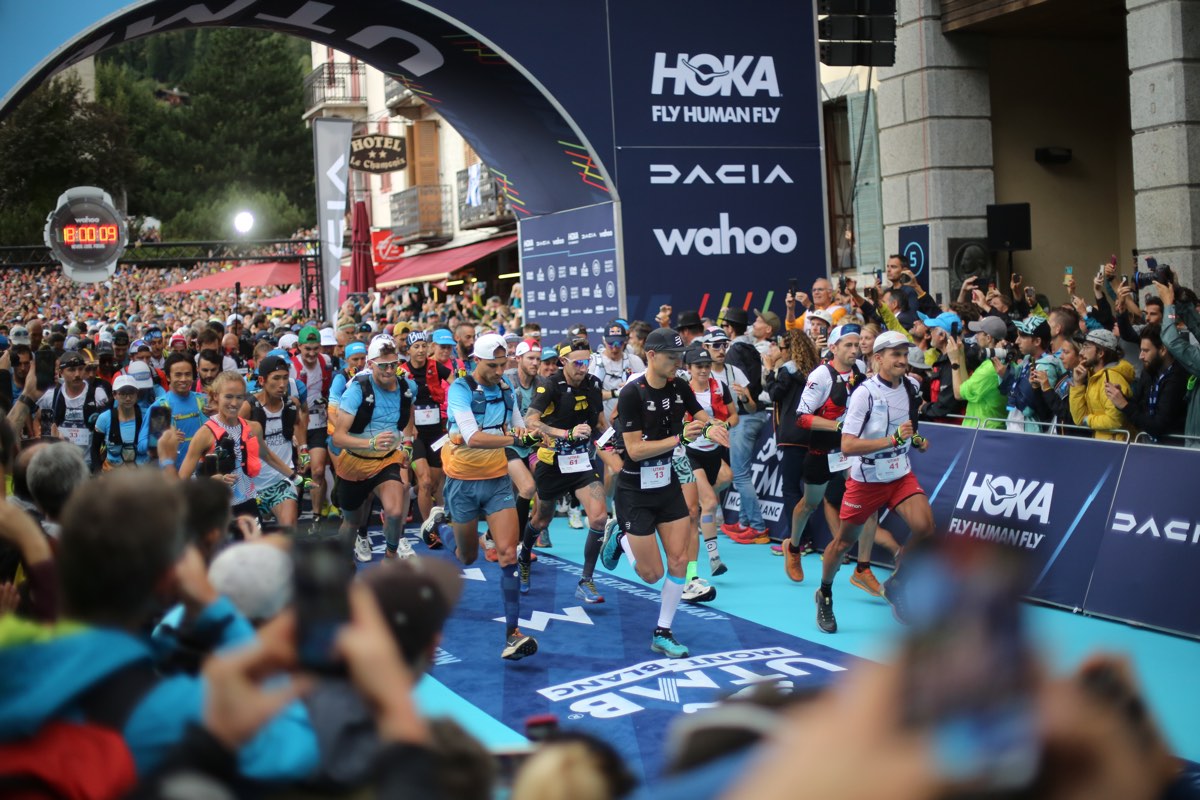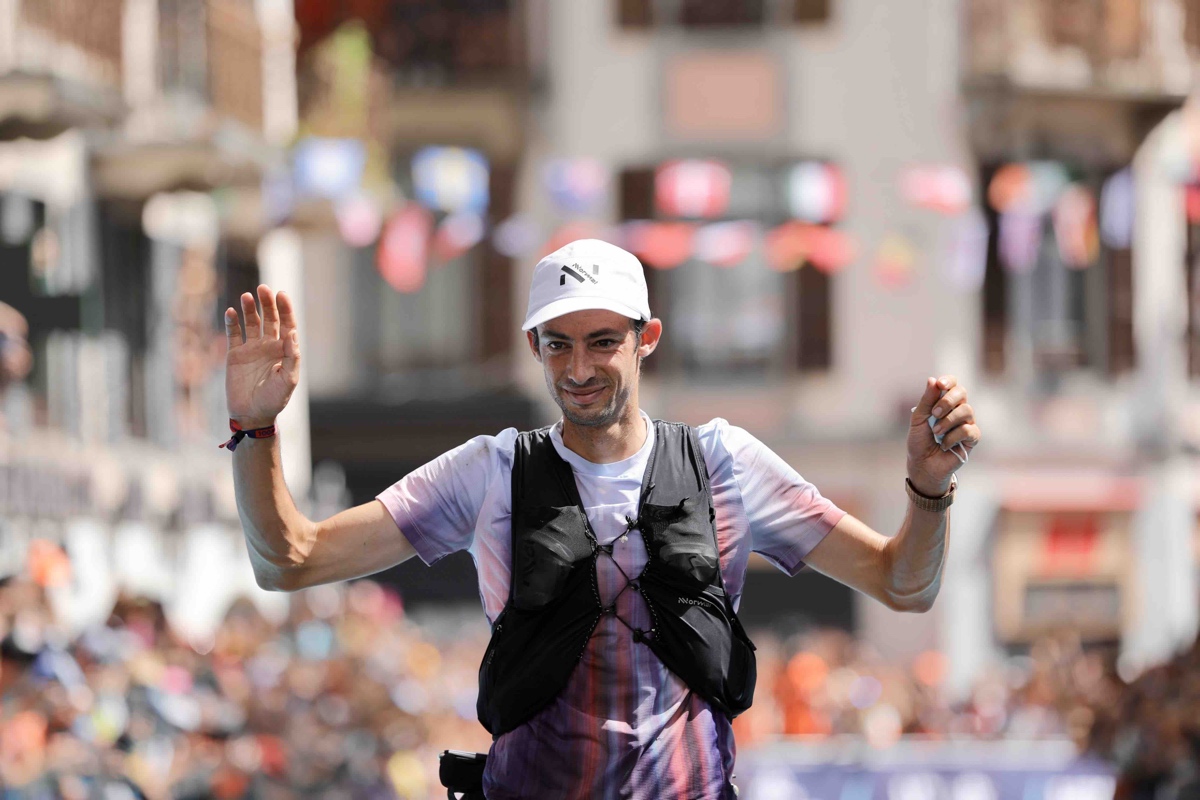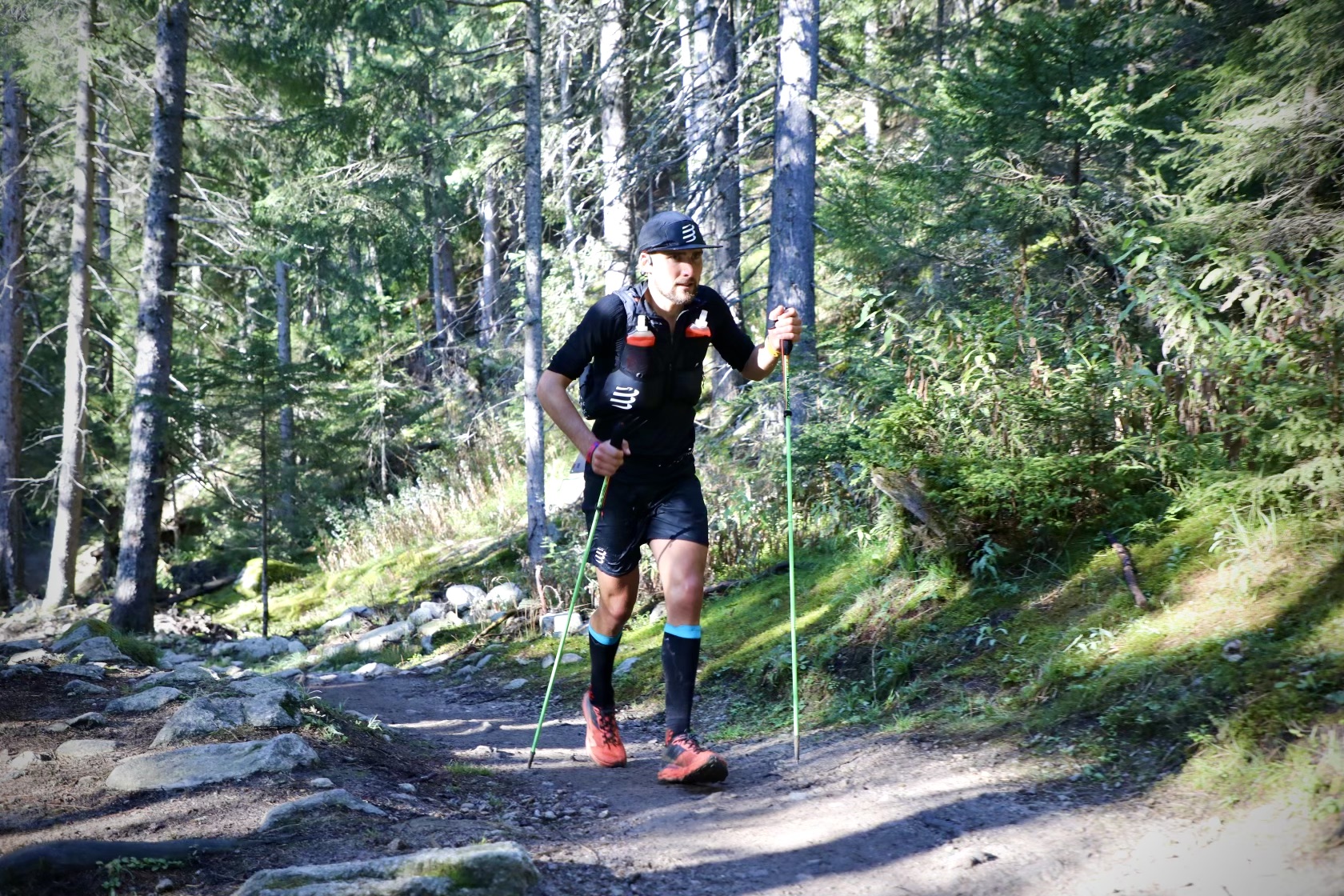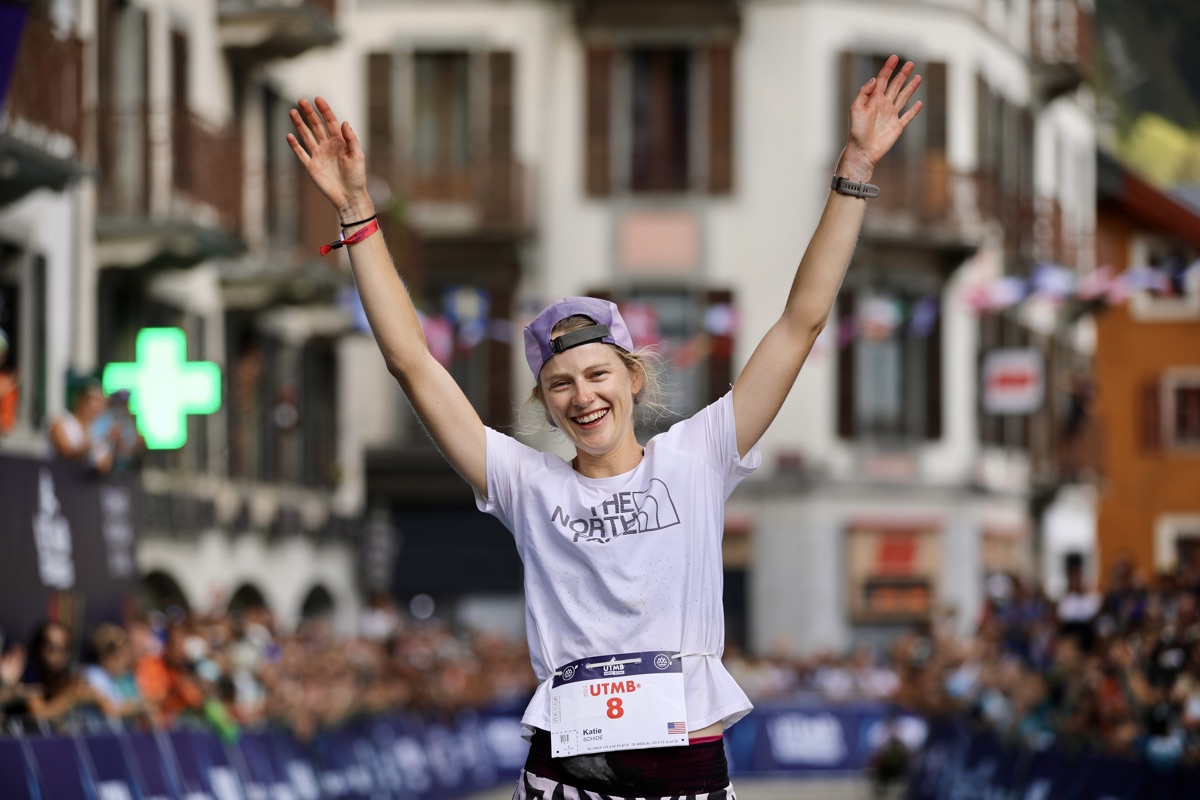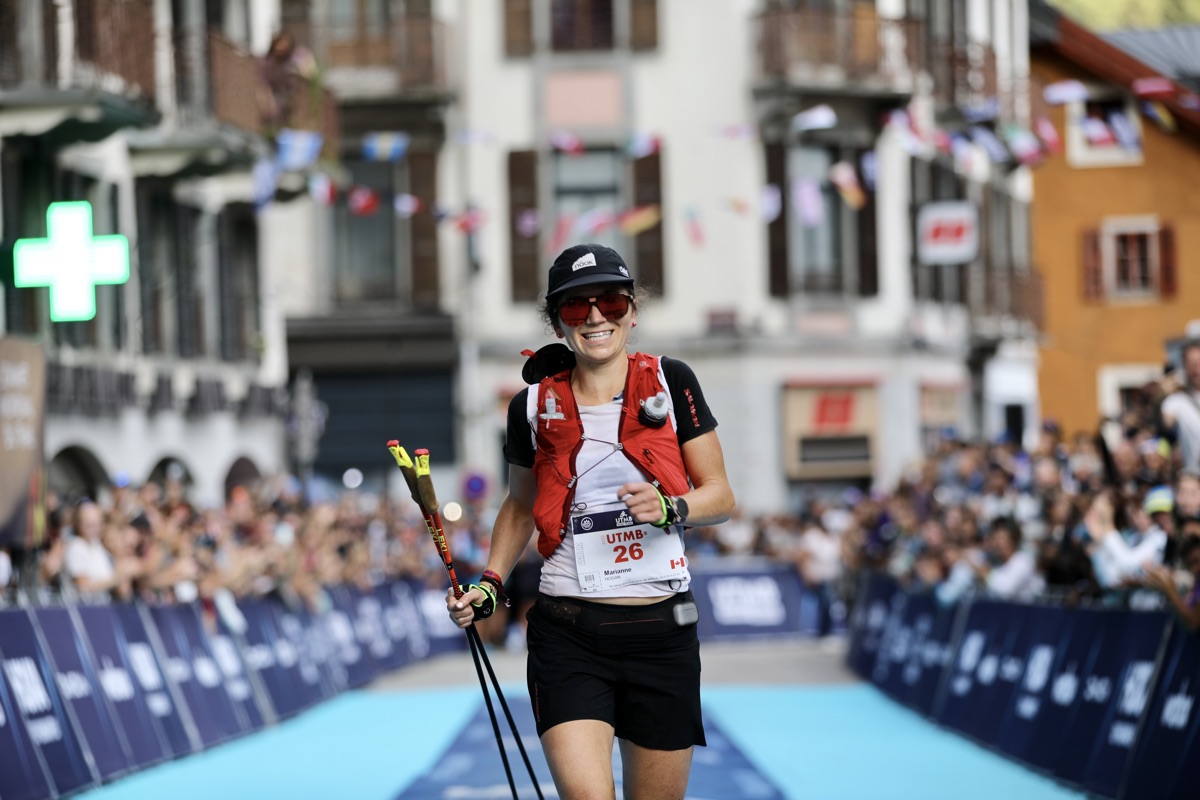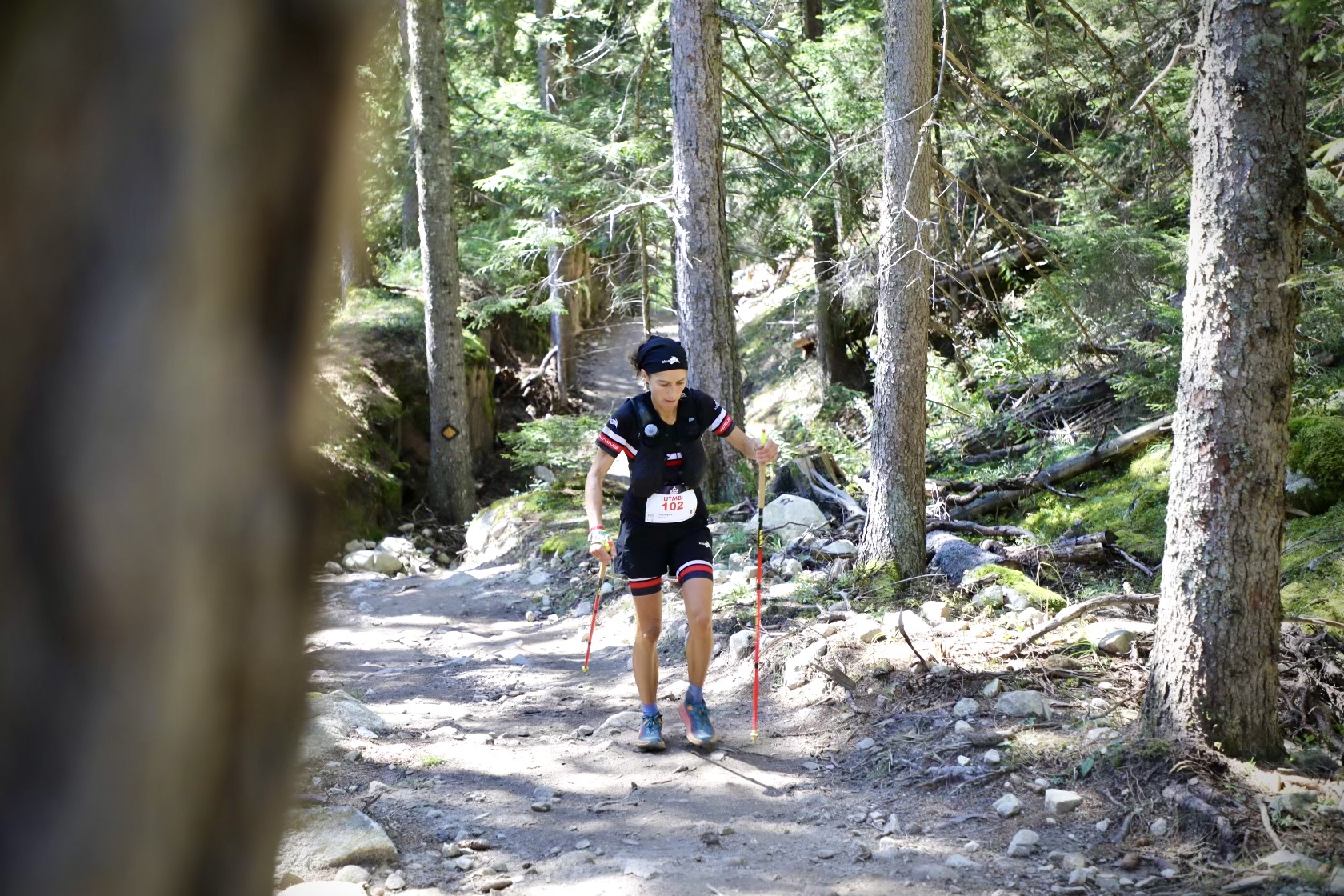This year’s UTMB men’s race was billed as a likely showdown between two of the greats in men’s ultrarunning, Jim Walmsley (pre-race interview) and Kilian Jornet (post-race interview), with predictions that whoever came out ahead would also hold a new course record. And while it initially seemed that the race would play out as expected, with Walmsley and Jornet trading blows for the first 142 kilometers, it would be Mathieu Blanchard (post-race interview) who made the final attempt to dethrone Jornet. But it was not to be, with Jornet breaking both previous course records, by a significant margin, in a time of 19:49:30.
The women’s side of the 2022 UTMB had an openness that perhaps fans had not felt in years. With no previous champions or clear favorites on the starting line, instead, we all ruminated about the 10 or 12 women with the potential to win or challenge for it. Even then, we all also noticed the deepening women’s field year over year, with this one likely requiring getting to the finish line quicker than was previously normal to secure a top-10 finish. From the start line, Katie Schide (pre– and post-race interviews) led aggressively, only relinquishing the lead for a handful of kilometers around daybreak during a rough patch, before getting her stomach under control and finishing with a time of 23:15:12 way in front of the rest of the field.
Covering 171.5 kilometers (106.5 miles), the UTMB creates an aesthetic and rugged loop around Mont Blanc in the Alps. Starting and ending in Chamonix, France, before paying a visit to both Italy and Switzerland, the loop has some 10,000 meters (32,800 feet) of elevation gain and loss. Arguably the most competitive trail ultramarathon of the year, UTMB is an event to behold. The final and most prestigious race of the week-long UTMB Mont-Blanc festival, it reliably draws top talent and some of the biggest crowds in the sport.
This year, 2,795 starters headed out from Chamonix at 6 p.m. on Friday, August 26, under cloudy skies and a sprinkle of rain, but with a forecast for potential rain and thunderstorms throughout the evening. The forecasted storms never really materialized, and runners enjoyed favorable weather throughout the race.
Jornet and Schide took similar paths to the win, both starting out strong before fading in the middle of the race and then surging to the front when it really mattered. And both saw strong challenges from second-place finishers, Blanchard and Marianne Hogan (post-race interview).
Several top runners would end up dropping out due to various ailments, including last year’s third-place woman Mimmi Kotka (pre-race interview) and sixth-place man Hannes Namberger (pre-race interview).
Enjoy our 2022 UTMB photo gallery as well.
A special thanks to HOKA for making our coverage of UTMB possible!

 Thanks also to Squirrel’s Nut Butter and BUFF® for their support of our UTMB coverage.
Thanks also to Squirrel’s Nut Butter and BUFF® for their support of our UTMB coverage.
2022 UTMB Men’s Race
As expected, the men took the race out fast from the start on the relatively flat roads and trails from Chamonix to the village of Les Houches. Spain’s Pau Capell (pre-race interview), the 2019 UTMB winner, led a charging group through Les Houches, seven kilometers into the race, followed closely by Mathieu Blanchard (post-race interview), a Frenchman living in Canada, and Jia-Ju Zhao and Guo-Min Deng, both of China. All the top contenders were in a massive chase pack, settling in for the long night and day ahead.
It didn’t take long for Jim Walmsley (pre-race interview) of the USA to make his intentions for this year’s race clear, coming into Saint-Gervais, at 20 kilometers into the race, in the lead, looking strong and relaxed. Kilian Jornet (post-race interview) and Capell were just seconds behind with Deng, Zhao, and American Zach Miller (post-race interview) making up a chase group half a minute in arrears. They were followed by Frenchman Germain Grangier, Blanchard, Frenchman Thibaut Garrivier, and Yan-Qiao Yun of China.
Unsurprisingly, by Les Contamines, 31 kilometers into the race, it was shaping up to be a showdown between Walmsley and Jornet. They came into the aid station together looking relaxed, Walmsley taking the time to high-five fans, and were shortly on their way into the night together. Capell and Miller came in just 30 seconds back, and Grangier rounded out the top five, just a minute behind them.
A notable withdrawal around this time due to physical issues is last year’s second-place finisher, Frenchman Aurélien Dunand-Pallaz (pre-race interview).
Climbing over the high Col du Bonhomme, 43 kilometers in, Walmsley, Miller, Jornet, and Tom Evans (pre-and post-race interviews) of the U.K. shared the lead. With 1,160 meters (3,800 feet) of climbing down just on this one climb, everyone in the group looked relaxed and was moving well. Capell was just 90 seconds back, trying not to let the elastic to the front group snap in the dark of the night on the run over to Col du Bonhomme before the long descent into the remote French outpost of Les Chapieux.

The U.K.’s Tom Evans on his way to the 2022 UTMB start line. He would eventually place third. Photo: iRunFar/Kirsten Kortebein
The four leaders stayed together down to Les Chapieux, 50 kilometers into the race, where last year’s winner, François D’Haene — not participating this year — was spectating and cheering on runners. Unfortunately, Capell had lost contact with the lead group over the previous section, coming into the aid station more than two minutes back. The rest of the top nine stayed relatively the same with Erik Sorenson of the USA slotting in 10th for the first time.
Coming into Lac Combal, 66 kilometers into the race, after crossing country borders into Italy and traversing the most remote part of the course, Walmsley and Jornet had only slightly pulled away, their gap to Miller and Evans hung at a tenuous minute. All four looked strong, but it seemed like pre-race predictions of a two-man showdown were about to be realized.
Walmsley, with his arms and legs fully covered from the cold of the night but shirt front open, came into the town of Courmayeur, 80 kilometers in, solo and in the lead, but his gap on Jornet was just 80 seconds. Both men were moving well and left the aid station together after only a few minutes.
It was a significant 12 minutes before Evans and Miller came through, staying in Courmayeur for under three minutes. Blanchard, looking more relaxed than any of the previous four, was also in and out of the aid station quickly, 18 minutes off the lead. Known for his slower starts and late race surges, Blanchard appeared to know exactly what he was doing.
It was never a question of if Walmsley or Jornet would strike out on their own, it was just a matter of when. Walmsley was the first to throw down a serious acceleration, coming into Arnouvaz (97 kilometers) solo and with a 2.5-minute gap on Jornet. Both were in and out of the aid station quickly, looking strong and motivated. Blanchard also chose the trail between Courmayeur and Arnouvaz to make his move, coming into the Arnouvaz aid station in third, looking very controlled and 14 minutes behind the leaders.
He was familiar with that position in the race, having finished third in UTMB in 2021. He was also familiar with the race tactic of starting slower, letting the leaders fight it out early and tire themselves out, and then moving up as the fast starters dropped back. It had brought him success the previous year, and he was seemingly employing the strategy again. Miller and Evans continued to run near each other, what Evans would later refer to as a “bromance” that lasted over half the race, and both looked like they had less spring in their step than the men ahead of them.
Committed to making the move stick, Walmsley climbed the Grand Col Ferret at 102 kilometers with a strong powerhike and held a five-minute gap over Jornet. Seemingly unconcerned with his position, Jornet chatted in French with both spectators and volunteers before vanishing into the night. Moving faster and looking stronger over the col than the previous two men, Blanchard continued the chase in third 17 minutes back. Miller and Evans continued to work together to keep the gap manageable.
The gap between Walmsley and Jornet stretched even further to 14 minutes by the sleepy Swiss village of La Fouly, 112 kilometers into the race. Both men were running under course-record pace, and both looked calm and collected. Still running strong into La Fouly, Blanchard kept the leaders within reach.
But Walmsley was committed to stretching the elastic on the field as much as he could, coming through Champex-Lac at 125 kilometers with 13 hours and 40 minutes on the race clock, gaining even more time on the course record and moving strongly. It’s generally a bad idea to bet against Walmsley after he’s put his mind to something, and after a fifth-place finish in 2017 and DNF in 2018 and 2021 at UTMB, his commitment to the race and move to Europe to train on the trails seemed to be paying off. But Walmsley is also known for going out fast and strong, and it doesn’t always stick.
One could argue that Jornet was just biding his time, letting Walmsley burn his matches out front. However, there were times around this point in the race when Jornet just plain looked like he was working, enough so that we all began to wonder if the GOAT of trail running would have a crack in his armor today. However, by Trient at 142 kilometers, Jornet had decided to make his move, coming into the aid station in the lead.
But instead of seeing Walmsley behind him, it was a surging Blanchard, less than a minute back, that Jornet would have to now battle. It was a long 19 minutes before Walmsley would arrive, appearing to be in discomfort. The dynamic duo of Evans and Miller continued to run together, still holding the gap to the race leader at just over 30 minutes, as they had for much of the race.
As the kilometers ticked down, it was indeed a showdown between two men, except it was Blanchard challenging Jornet, with both men coming into Vallorcine at 153 kilometers together, well ahead of the course-record pace. With Walmsley slowly losing time to the leaders but still in third, eyes moved to Evans who’d finally dropped Miller after nearly a night and a day of racing side by side to see if he could make the pass.

The 2022 UTMB men’s podium (l-to-r): 2. Mathieu Blanchard, 1. Kilian Jornet, and 3. Tom Evans. Photo: iRunFar/Bryon Powell
By this time, it felt nearly inevitable that Jornet would run to the win and it was no surprise when he came into Tete aux Vents solo looking focused and fast with an 11-kilometer downhill run to the finish. Blanchard never gave up the chase, seven minutes back, while Evans passed a tired but “pumped” Walmsley to slot into third for the first time.
Jornet would finish with a course-record time of 19:49:30, besting both François D’Haene’s 2014 record time (20:11:44) on a course that did not include the Pyramides Calcaires, a gnarly little climb and descent added to the UTMB course a few years back, and Capell’s 2019 time (20:19:09), which did include those extra kilometers. This is his fourth win at UTMB. Just five minutes back, Blanchard would also come into the finishing chute under the previous course record in second place. An elated Evans rounded out the podium, a stellar finish for his first UTMB.
Walmsley came across the line in fourth, releasing the two DNF monkeys on his back and finishing the next step in his goal of ultimately winning this race someday. Miller, no longer on the comeback trail following surgery and recovery, but fully back, crossed the line in fifth place.
Most of the back half of the men’s top 10 are runners who started slower and bided their time, moving up in the race’s second half, including France’s Beñat Marmissolle, France’s Arthur Joyeux-Bouillon, Jonas Russi of Switzerland, and Romania’s Robert Hajnal. The final member of the men’s top 10, however, is France’s Thibaut Garrivier, who went out hot and looked like he paid for it later, but ultimately held onto 10th place.
2022 UTMB Men’s Results
- Kilian Jornet (NNormal) – 19:49:30 (post-race interview)
- Mathieu Blanchard (Salomon) – 19:54:50 (post-race interview)
- Tom Evans (adidas Terrex) – 20:34:35 (pre-and post-race interviews)
- Jim Walmsley (Hoka) – 21:12:12 (pre-race interview)
- Zach Miller (The North Face) – 21:27:50 (post-race interview)
- Beñat Marmissolle (Asics) – 21:28:14
- Arthur Joyeux-Bouillon (Compressport) – 21:35:45
- Jonas Russi (Hoka) – 21:46:26
- Robert Hajnal (Altra) – 22:07:58
- Thibaut Garrivier (Hoka) – 22:09:19
- Andy Symonds (SCOTT) – 22:24:28
- Thibault Marquet (CMAB) – 22:26:33
- Alban Berson (Altra) – 22:27:39
- Jimmy Elam (Altra) – 22:36:10
- Guillaume Deneffe (TRAKKS Belgium) – 22:40:05
- Jeff Mogavero (HOKA) – 22:52:00
- Jhon Barrera – 22:54:25
- Alexandre Boucheix (Casquette Verte) – 22:55:30
- Mark Darbyshire – 23:03:42
- Guo-Min Deng (The North Face) – 23:04:39

The scene at the Courmayeur aid station, about 80 kilometers into the 2022 UTMB. Photo: iRunFar/Bryon Powell
2022 UTMB Women’s Race
An American living in France and eighth-place finisher at UTMB in 2021, Katie Schide (pre– and post-race interviews) set out to make her mark on the race from the beginning, leading the women’s field after seven kilometers into Les Houches while being trailed closely by the trio of Marianne Hogan (post-race interview) from Canada, Kaytlyn Gerbin (post-race interview) from the USA, and Hillary Allen from the USA.
Schide grew the gap over the next 13 kilometers into Saint-Gervais. With only one hour and 48 minutes on the race clock, a truly raw opening effort, her lead over second place Hogan was already five minutes, and she had eight minutes on third place Audrey Tanguy (pre-race interview) of France. Jocelyne Pauly and Manon Bohard, both from France also, came through in fourth and fifth with Mimmi Kotka (pre-race interview), a Swede living in Chamonix, just behind them in sixth. Fu-Zhao Xiang (pre-race interview) of China, Ragna Debats (pre-race interview), who is Dutch but lives in Spain, and Azara García (pre-race interview) of Spain rounded out the top 10, running together 13 minutes behind Schide.
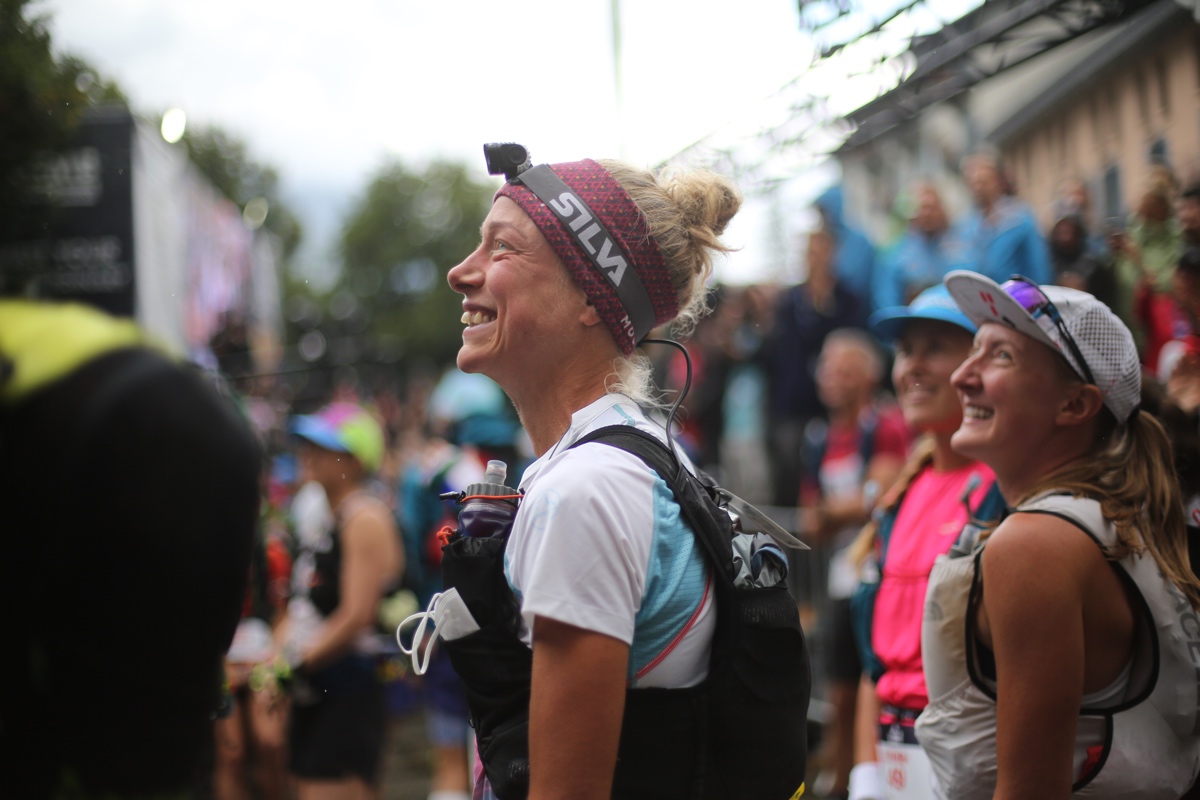
Mimmi Kotka (left) and Kaytlyn Gerbin take in the scene at the 2022 UTMB start line. Hillary Allen also looks on in the background. Photo: iRunFar/Kirsten Kortebein
Keeping up her consistent and strong pace, Schide continued to increase her lead on the rest of the women’s field, coming into Les Contamines at 31 kilometers with 2:50 on the race clock. By then, she’d extended her lead on Hogan to over nine minutes, Tanguy to 12 minutes, and Bohard and Pauly to 15 minutes. Tanguy was probably relieved to make it past Les Contamines where she had dropped last year from severe stomach cramps. A visibly limping Kotka, who had challenged Courtney Dauwalter during last year’s UTMB during the early miles of the race before finishing third as Dauwalter won, came into Les Contamines nearly 20 minutes off the lead in sixth and would not continue.
Schide continued to smile coming through the Col du Bonhomme, at about a marathon’s distance into the race, clearly enjoying her run through the night and appreciating the cheers of the spectators. Climbing one of the largest passes of the race only seemed to make her stronger. Her gap to Hogan and Tanguy had grown to about 20 minutes as the two chasers crested the col. The cheers from the enthusiastic French crowd brought smiles to both women’s faces as they passed through. The cheers continued for Bohard and Pauly, who were still running together.
The crowd at Les Chapieux, 50 kilometers in, was enthused to see Schide, erupting in huge cheers as she came in. While the gaps between the women in second through 10th grew and shrunk over the kilometers, Schide’s gap on the field had only gone one direction so far: up. She was now more than 22 minutes up on second place Hogan. By the time Schide got to Lac Combal, 66 kilometers into the race, the gap was up to 25 minutes, and it would be an additional 20 minutes for Tanguy to arrive after that.
With 80 kilometers run, Schide came into Courmayeur flying, spending only eight minutes at the aid station approximately halfway into the race. The crowds were thrilled to see her, providing a warm and raucous welcome as she ran into the aid station looking smooth. But for the first time in the race thus far, Hogan had started to close the gap to the leader, whittling it down to just over 20 minutes. Smiling but with a stomach that couldn’t handle gels anymore, she quickly drank a Coke and opted for pizza for fuel. The gap between the top two women and the rest of the field continued to grow, and it was over an hour before Tanguy, Pauly, and Gerbin ran through, and a few more minutes after them to the sixth woman, Emily Hawgood, of Zimbabwe, who lives in the USA.
While Schide had seemed unstoppable before Courmayeur, the tables seemed to turn over the next 17 kilometers to Arnouvaz as night turned to day. Schide came in with stomach issues, clearly in a rough spot, with Hogan hot on her heels, now only two minutes behind. Closing a gap of more than 18 minutes is a feat to be acknowledged, and a feisty and strong Hogan seemed energized by the coming of the day and the idea of leading the race for the first time.
A struggling Schide maintained her lead over the Grand Col Ferret at 102 kilometers, but it was down to a minute, and when the women’s leader arrived at La Fouly at 112 kilometers, it was Hogan instead of Schide for the first time, with a sizable six-minute gap. By Champex-Lac at 125 kilometers, it was still Hogan in the lead and well under course record pace, now with a 10-minute gap to second. But Schide wasn’t about to give up, slowing down to let her stomach recover from its previous rough spell, and finally eating a cheese sandwich and starting to move well again.
One hundred miles is a long distance to race, long enough that runners can get through rough spells and rebound. And that’s exactly what Schide did, regaining the lead in Trient at kilometer 142, not only eliminating the 10-minute gap but putting an additional 10 minutes on Hogan. By Vallorcine at 153 kilometers, the gap between the top two was up to 41 minutes, with Hogan nursing a hurt left leg. By the time the pair reached the finish line in Chamonix, they maintained their one-two position with Schide having extended the gap to some 75 minutes.
It was another 35 minutes later that we saw the final member of the women’s podium arrive, Gerbin, who ran for much of the second half of the race in what she described as “no woman’s land,” well in front of those behind her but out of contact with the lead. It was apparently a comfortable spot for her, though, as she held her position strongly, and crossed the finish line back in Chamonix like she could run plenty more kilometers if needed.
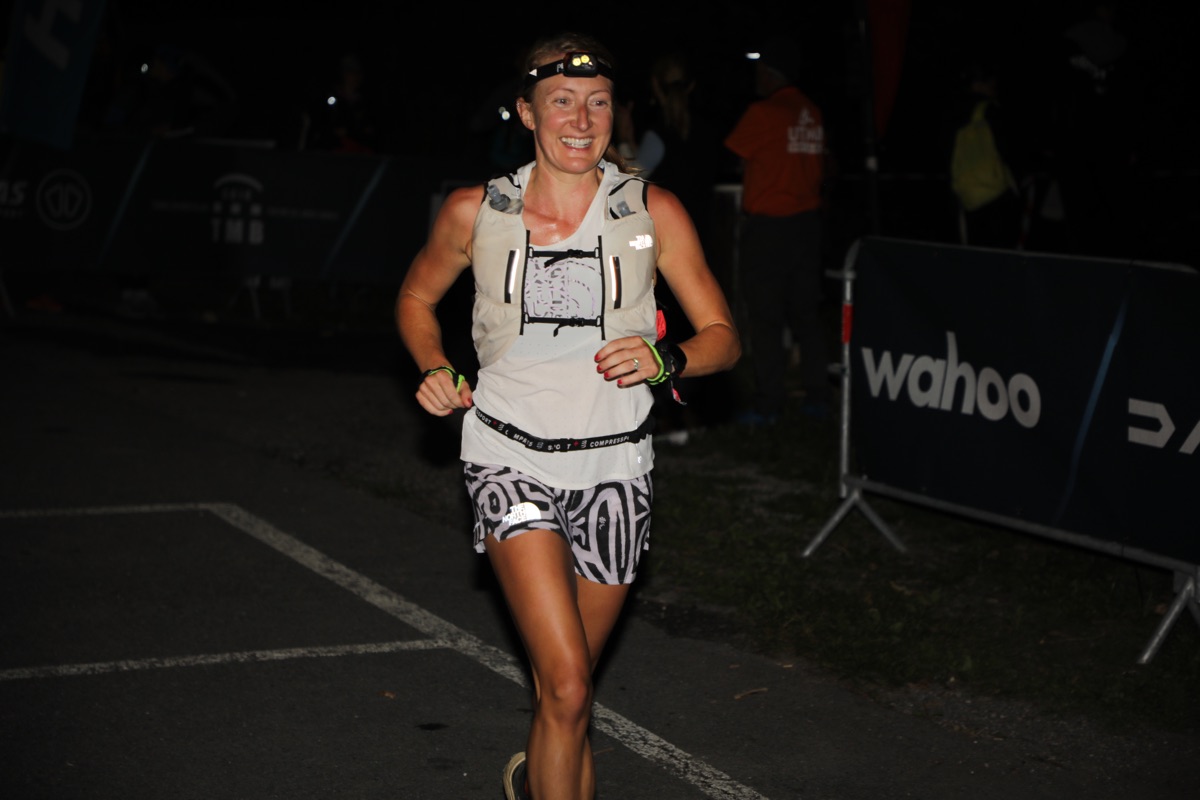
Kaytlyn Gerbin in the early hours of the 2022 UTMB, where she took third. Photo: iRunFar/Bryon Powell
Pauly finished fourth, the successful conclusion of a focused day of racing. Eszter Csillag (post-race interview), who is from Hungary but lives in Hong Kong, moved up later on to take fifth. Emily Hawgood ran strong all day to set and maintain a very similar position of sixth place. Xiang held tight to seventh place with Spain’s Aroa Sio just behind in eighth. Italy’s Francesca Pretto and Eva-Maria Sperger of Germany moved up into the top 10 in the last 50 kilometers.
2022 UTMB Women’s Results
- Katie Schide (The North Face) – 23:15:12 (pre– and post-race interviews)
- Marianne Hogan (Salomon) – 24:31:22 (post-race interview)
- Kaytlyn Gerbin (The North Face) – 25:07:24 (post-race interview)
- Jocelyne Pauly – 26:13:58
- Eszter Csillag (T8) – 26:32:39 (post-race interview)
- Emily Hawgood (adidas Terrex) – 26:37:08
- Fu-Zhao Xiang (Hoka) – 27:14:21 (pre-race interview)
- Aroa Sio (Craft) – 27:17:49
- Francesca Pretto (La Sportiva) – 27:31:46
- Eva-Maria Sperger (Salomon) – 28:15:29
- Paulina Krawczak – 28:21:22
- Emily Vaudan (Salomon) – 28:36:21
- Kaori Niwa (Salomon) – 28:54:33
- Hillary Allen (Brooks) – 29:09:43
- Basilia Förster – 29:10:11
- Mélanie Delasoie – 29:28:44
- Lou Clifton – 30:21:16
- Katrzyna Solińska (On Running) – 30:35:13
- Claire Heslop – 30:38:58
- Anete Svilpe (inov-8) – 31:24:09

